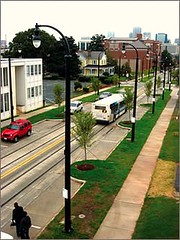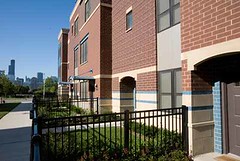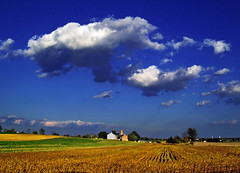Smart growth exemplars honored by EPA

Posted December 3, 2009 at 2:34PM
Earlier this week the federal Environmental Protection Agency announced the winners of its 2009 national awards for smart growth achievement. I attended the ceremony at the National Building Museum and, this year, was also honored to be on the jury that selected the finalists from which the agency made its choices.
It's an interesting and worthy bunch. I plan to write separate posts about each of the winners and, today, present an overview:
I've already written, actually, about the Tempe Transportation Center, an amazing mixed-use facility that embodies the best of smart growth, green building, sustainable transportation and exciting design in one project. On track to receive LEED-platinum green building certification, the new center connects Tempe's downtown (and Arizona State University) light rail station with eleven bus lines, walkable downtown and university destinations (I can well imagine the congestion relief provided by the Center's proximity to Sun Devil Stadium), cycling routes, and a wonderful bike station that provides secure indoor storage, showers for bike commuters, and a bike repair shop. It also provides a neat transition between the city and Hayden Butte, which contains archeological features dating back to the fifth century. The center won the award for smart growth and green building.
The City of Charlotte won the award for policies and regulations, for its urban street design guidelines. EPA's description notes that the city is "using street design to shape its development patterns and provide residents and visitors with viable choices for how they move about the city. The guidelines include innovative policies, implementation processes, and a variety of street types. Also included is a six-step planning and design process that matches each street to the existing and emerging land use context." EPA goes on to note that the process helps planners design streets that are sized appropriately for their neighborhood context and select streetscape elements that create an appealing environment and keep pedestrians, bicyclists, transit riders, and motorists safe. The city's DOT director, Danny Pleasant, was eloquent about these things in his acceptance at the ceremony, and I look forward to writing more about what makes the Charlotte guidance a worthy exemplar.
Parkside of Old Town is a HOPE VI development in Chicago that partially replaces the large, notorious and crime-ridden Cabrini Green public housing project whose well-publicized demolition began early in the decade. EPA's citation says:
"This two-phase, 800-unit housing project replaced a failed segregated housing project with a mixed-use, socioeconomically diverse neighborhood. The design seamlessly blends a variety of housing options and pricing levels with the larger city. Inside the neighborhood, rental, market-rate, and affordable housing units are indistinguishable, leading to a cohesive community. The design incorporates pedestrian pathways and reestablishes the original street grid to enhance the link between the community and downtown Chicago."
More about Parkside, which won the award for built projects, in a future post.
The big winner for "overall excellence in smart growth" is the Envision Lancaster County (PA) comprehensive plan. EPA's citation says that ELC is "a comprehensive, multi-staged countywide plan to manage growth and maintain the county's distinctive sense of place" (Lancaster is the heart of Pennsylvania Dutch country) over the next 25 years. Envision Lancaster County "directs new development to existing towns to protect the farmland, rural areas, and natural landscapes that define the county's character. The plan considers the entire region by promoting reinvestment in existing communities and encouraging more compact, interconnected neighborhoods. By doing so, the plan preserves open space, protects water resources, and provides for greater housing and transportation choices."
By coincidence, I have already had a post on Lancaster in the works, as the result of a Congressional briefing a few weeks ago about "my" new book (I contributed a chapter), Green Community. One of my co-authors and co-presenters at the briefing was Tom Daniels, who has been involved in Lancaster's conservation efforts. More about this soon; I hope to be able to tell a story that's more optimistic than my last post about the county, suggesting that planners there have some significant problems to overcome if they are to achieve their vision.
The EPA awards ceremony featured an articulate and on-message speech by EPA administrator Lisa Jackson, videos of each winner, and a panel discussion among the winning sponsors, moderated by Juliet Eilperin of The Washington Post.



